Application of Artificial Neural Network Approach for Estimating Reference Evapotranspiration
Khyati N. Vyas1 * and R. Subbaiah2
Corresponding author Email: khyativyas46@gmail.com
DOI: http://dx.doi.org/10.12944/CWE.11.2.36
The process of evapotranspiration (ET) is a vital part of the water cycle. Exact estimation of the value of ET is necessary for designing irrigation systems and water resources management. Accurate estimation of ET is essential in agriculture, its over-estimation leads to cause the waste of valuable water resources and its underestimation leads to the plant moisture stress and decrease in the crop yield. The well known Penman-Monteith (PM) equation always performs the highest accuracy results of estimating reference Evapotranspiration (ET0) among the existing methods is without any discussion. However, the equation requires climatic data that are not always available particularly for a developing country. ET0 is a complex process which is depending on a number of interacting meteorological factors, such as temperature, humidity, wind speed, and radiation. The lack of physical understanding of ET0 process and unavailability of all appropriate data results in imprecise estimation of ET0. Over the past two decades, artificial neural networks (ANNs) have been increasingly applied in modeling of hydrological processes because of their ability in mapping the input–output relationship without any understanding of physical process. This paper investigates for the first time in the semiarid environment of Junagadh, the potential of an artificial neural network (ANN) for estimating ET0 with limited climatic data set.
Copy the following to cite this article:
Vyas K. N, Subbaiah R. Application of Artificial Neural Network Approach for Estimating Reference Evapotranspiration. Curr World Environ 2016;11(2) DOI:http://dx.doi.org/10.12944/CWE.11.2.36
Copy the following to cite this URL:
Vyas K. N, Subbaiah R. Application of Artificial Neural Network Approach for Estimating Reference Evapotranspiration. Curr World Environ 2016;11(2). Available from: http://www.cwejournal.org/?p=16076
Download article (pdf) Citation Manager Publish History
Select type of program for download
| Endnote EndNote format (Mac & Win) | |
| Reference Manager Ris format (Win only) | |
| Procite Ris format (Win only) | |
| Medlars Format | |
| RefWorks Format RefWorks format (Mac & Win) | |
| BibTex Format BibTex format (Mac & Win) |
Article Publishing History
| Received: | 2016-05-21 |
|---|---|
| Accepted: | 2016-08-22 |
Introduction
In semi arid regions, water resources management is a crucial requirement for increasing agricultural production because food insecurity is becoming a main concern. ET is one of the hydrologic cycle components and the precise estimation of ET is very important for the researches such as water balance, irrigation design and management, crop yield modelling, and water resources planning and management reported by Kumar et al.5 (2002). ET0 can be obtained by many estimation methods, but Shih et al.6 (1983) reported that the factors such as data availability must be considered when choosing the ET0 calculation technique. The Penman-Monteith method is maintained as the single standard method recommended by the FAO for the computation of ET0 from complete meteorological data [Allen et al.2 (2006); Smith et al.7 (1990)] but, the main shortcoming of the FAO 56 PM method is, it requires large number of climatic parameters that are not always easily available for many locations. Several models such as Hargreaves and Blaney-Criddle and other models have been proposed to predict ET0, but Traore et al.8 (2008) reported that, these models do not have universal consensus for different climatic conditions. ET0 is a complex process which is depending on several interacting climatological factors, such as temperature, humidity, wind speed, and radiation. The lack of physical understanding of ET0 process and unavailability of all relevant data results in inaccurate estimation of ET0. Over the past two decades, artificial neural networks (ANNs) have been used more and more in modeling of hydrological processes because of it has ability in mapping the input–output relationship without any understanding of physical process. The feed-forward multi-layer perceptron (MLP) is widely adopted ANN in most of the studies on hydrological modeling. ANNs are capable of modeling complex nonlinear processes effectively extracting the relation between the inputs and outputs of a process without the physics being explicitly provided to them and also, they identify the underlying rule even if the data is noisy and contaminated with errors, suggested by ASCE3 (2000a) and ASCE4 (2000b).
Accurate estimation of Evapotranspiration is more important for water users, for parameterization of important hydrologic and water resources planning and operation models, for operating weather and climate change forecasting models, forecasting of drought and its monitoring, effective development and utilization of water resources, water management and allocation in water-scarce regions, including the partitioning of water resources among states and nations. There are lots of different kinds of Evapotranspiration estimation methods. Those all methods are based on existing hydrological models and their meteorological data input requirements. The goal of this study is to develop the ANN based models which perform close to FAO 56 PM estimates and required less meteorological data because in un-gauged basins the meteorological information is generally unavailable. In such circumstances models requiring low meteorological data which yield accurate results whereas intensive data requiring models cannot be adopted due to lack of meteorological information.
Material and Methods
Study Area
Reference evapotranspiration was estimated for Junagadh, Gujarat, India. Study region falls under south Saurashtra zone agro climate zone. Junagadh has bearings of 69.40° to 71.05 ° East Longitude and 20.44 ° to 21.40 ° North Latitude with 83 m above MSL (Mean Sea Level). The climate of the area is categorized under subtropical and semi-arid with an average annual rainfall of 900 mm and average pan evaporation of 6.41 mm/day. May is the hottest month with mean weekly pan evaporation of 10.95 mm and mean monthly temperature varying between 35°C to 45°C. January is the coolest month with mean monthly minimum temperature varying between 7°C to 10°C. About 95% of the total rainfall is received during monsoon months only.
Description of Input Weather Parameters
In the present study daily meteorological data for the period of January 1984 to December 2012 years was collected from Agro-meteorological observatory, Junagadh Agricultural University, Junagadh, and were used to estimate reference evapotranspiration. Four meteorological parameters temperature, wind speed, bright sunshine hours, relative humidity have been collected for a period of twenty nine years. In some models the solar radiation was used instead of bright sunshine hours for finding the effect in estimating reference ET.
Penman-Monteith Equation
The FAO Penman–Monteith method was developed by defining the reference crop as a hypothetical crop with an assumed height of 0.12 m having a surface resistance of 70 s m-1 and an albedo of 0.23, closely resembling the evaporation of an extensive surface of green grass of uniform height, actively growing and adequately watered.
The FAO Penman-Monteith method for calculating reference (potential) evapotranspiration ET can be expressed as Allen et al.1 (1998):

Where, ET0 is reference evapotranspiration [mm day-1], Rn is net radiation at the crop surface [MJ m-2 day-1], G is soil heat flux density [MJ m-2 day-1], Ta is mean daily air temperature at 2 m height [°C], u2 is wind speed at 2 m height [m s-1], es is saturation vapour pressure [kPa], ea is actual vapour pressure [kPa], (es - ea) is saturation vapour pressure deficit [kPa], Δ is slope vapour pressure curve [kPa °C-1], and γ is Psychrometric constant [kPa °C-1].
ANN Architecture
The number of nodes in the input layer depends on the number of climatic variables used in estimating ET0. The individual node in the input layer corresponds to respective variables. Thus, the number of nodes in the input layer varies according to the climatic data requirement of the model. The decision maker must specify the number of hidden layers and neurons in each hidden layer. In this study single hidden layer is used to develop the ANN models.
The available data are commonly split in three separate data sets: (1) the training set, (2) the cross-validation set, and (3) the validation set. The total available data is divided into three main categories, twenty three years (1984-2006) data is used for training and cross validation of the model; and the remaining data is applied for testing of model. Remaining six years (2007-2012) data were applied for testing of the model. Trial and error method is applied for weighing and training the model to achieve the desired target. The model is implemented using MATLAB. Feed forward and Back Propagation Algorithm was applied for the model development. The neural network structure in this study possessed a three-layer learning network consisting of an input layer, a hidden layer and an output layer. Each layer composed of a number of processing nodes called neurons with connections linking the nodes in successive layers. Fig. 1 shows the mathematical representation of typical configuration of a BP used in this study for modeling the ET0 process.
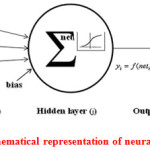 |
|
Data Normalization
For data standardization, the data of input and output nodes were scaled in the range of [0 1] using the following equation

Where, Ynorm = the normalized dimensionless data of the specific input node; Yi = the observed data of the specific input node; Ymin = the minimum data of the specific input node; and Ymax = the maximum data of the specific input node.
Applying Neural Networks to ET0
Daily mean temperature (Ta) and relative humidity (Rh), wind speed at 2 m level (W), maximum and minimum temperatures (Tmax, and Tmin) and total solar radiation (Rs) have been used as input-data for Penman-Monteith equation. The main input variables accounted for ANN include mean air temperature, mean relative humidity, wind speed, solar radiation and sunshine hours. The aim of the present study was to explore the potential of the ANN model for predicting ET0 of the study area at monthly time scale. Then in order to best network configuration determined was used to train and test several other input combinations represented in table 1 in order to apprehend the potential input variables affecting the ET0 process. This may help to understand the weather influence on ET0. Estimated ET0 calculated by using the PM method (FAO 56) for monthly time scale were considered the output for all ANN models. MODEL -1 to MODEL -5 has only one variables defined above. In this effect of individual variable on reference ET was analyzed. The extraterrestrial solar radiation is not a collected data but determined for a certain day and location of the Allen et al. (1998) procedure. The input structures of MODEL -6 to MODEL -11 are formed by inserting combination of two variables out of five. Then, the model of MODEL -12a to MODEL -15 integrated three variables out of five mainly mean air temperature, mean relative humidity, wind speed, solar radiation and sunshine hours. Finally all the parameters are integrated in the MODEL 16a and MODEL 16b predict the PM reference evapotranspiration.
Table 1: Different input combinations for regression model development
|
Input combinations |
Name of models |
Output |
|
Ta |
Model-1 |
ET0 (PM) |
|
Rh |
Model-2 |
ET0 (PM) |
|
W |
Model-3 |
ET0 (PM) |
|
N |
Model-4 |
ET0 (PM) |
|
Rs |
Model-5 |
ET0 (PM) |
|
RhW |
Model-6 |
ET0 (PM) |
|
RhN |
Model-7a |
ET0 (PM) |
|
RhRs |
Model-7b |
ET0 (PM) |
|
WN |
Model-8a |
ET0 (PM) |
|
WRs |
Model-8b |
ET0 (PM) |
|
TaN |
Model-9a |
ET0 (PM) |
|
TaRs |
Model-9b |
ET0 (PM) |
|
TaRh |
Model-10 |
ET0 (PM) |
|
TaW |
Model-11 |
ET0 (PM) |
|
TaWN |
Model-12a |
ET0 (PM) |
|
TaWRs |
Model-12b |
ET0 (PM) |
|
RhWN |
Model-13a |
ET0 (PM) |
|
RhWRs |
Model-13b |
ET0 (PM) |
|
TaRhN |
Model-14a |
ET0 (PM) |
|
TaRhRs |
Model-14b |
ET0 (PM) |
|
TaRhW |
Model-15 |
ET0 (PM) |
|
TaRhWRs |
Model-16a |
ET0 (PM) |
|
TaRhWN |
Model-16b |
ET0 (PM) |
(Ta = mean air temperature in °C, Rh = mean relative humidity in %, W = wind speed in m/sec, N = bright
sunshine hours in hr, Rs = solar radiation in MJ/m2/day)
Performance evaluation criteria
In this section, other error measures are, therefore, employed to quantify these deficiencies. The efficiency criteria used in this study are Root mean square error (RMSE), Nash-Sutcliffe efficiency (EF), coefficient of determination (R2), Coefficient of residual mass (CRM), Absolute error (AE), Akaike information criteria (AIC), Bayesian information criteria (BIC) and Mean square error (MSE), Adjusted R2. A brief of the above criteria is presented in the Table 2.
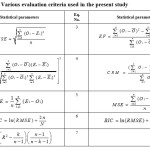 |
|
Results and Discussion
Table 3 and 4 shows the different performance indices of all combination based ANN models during training and testing respectively. From the tables and graphs one can say that after replacing the (Rs) in the place of bright sunshine hours (N), the performance of that relevant model is increased up to appreciable level. From the one input based models Rh based model gave very poor performance similarly, RhN and RhWN also gave poor performance from the two and three input combinations based models respectively. Performance of one input based models can be arranged in increasing order is Rh, W, N and Ta. Similarly, RhN, TaW, RhW, WN, TaN, RhRs, TaRs and WRs for two input combination based models and RhWN, TaRhN, TaRhRs, TaRhW, TaWN, RhWRs and TaWRs for three input combinations based models can be arranged in increasing order as per performance indices. Four input combination based models achieve the highest model efficiency.
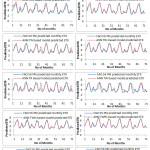 |
|
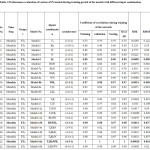 |
|
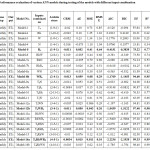 |
|
Conclusion
Study revealed that, the model-5 (Rs based) gave good result from one input combination based models. Similarly, model-8b (WRs), model-13b (RhWRs) and model-16a (TaWRhRs) performed excellent (near to PM FAO-56) from two, three and four input combination based ANN models for estimating monthly reference evapotranspiration for given area respectively. Solar radiation (Rs) is more accurate then the bright sunshine hours (N) for the estimation of ET0.
References
- Allen, R.G.; Pereira, L.S.; Raes, D. and Smith, M. Crop Evapotranspiration guidelines for computing crop water requirements. Irrigation and Drain, Paper No. 56. FAO, Rome, Italy, 300, (1998).
CrossRef - Allen R. G., Pruitt W. O., Wright J. L., Howell T. A., Ventura F., Snyder R., Itenfisu D., Steduto P., Berengena J., Yrisarry J. B., Smith M., Pereira L. S., Raes D., Perrier A., Alves I., Walter I. and Elliott R. A recommendation on standardized surface resistance for hourly calculation of ET0 by the FAO56 Penman-Monteith Mtd. Water Mgt., 81:1-22, (2006).
- ASCE Task Committee on Application of Artificial Neural Networksin Hydrology. Artificial Neural Networks in hydrology, I: Preliminary Concepts. Journal of Hydrologic Engineering, 5(2):115– 123, (2000a).
CrossRef - ASCE Task Committee on Application of Artificial Neural Networksin Hydrology. Artificial Neural Networks in hydrology, II: Hydrological Applications. Journal of Hydrologic Engineering, 5(2): 124–137, (2000b).
CrossRef - Kumar, M.; Raghuwanshi, N.; Singh, R.; Wallender, W. and Pruitt, W. Estimating evapotranspiration using artificial neural network. Journal of Irrigation and Drainage Engineering, 128(4): 224–233, (2002).
CrossRef - Shih S. F., Allen L. H., Hammond L. C., Jones J. W., Rogers J. S. and Smajstrla A. G. Basin wide water requirement estimation in southern Florida. Soc. Agric. Eng., 26:760-766, (1983).
CrossRef - Smith M., Allen R., Monteith J. L., Perrier A., Pereira L. S., Segeren A. Expert consultation report on revision of FAO methodol for crop water requirements held in Rome, Italy. Land and Water Dev. Division, May 28-31, pp. 1-59, (1990).
- Traore S, Wang YM, Kerh T. Modeling reference evapotranspiration by generalized regression neural network in semiarid zone of Africa. WSEAS Trans. Inf. Sci. Appl.,6:991-1000,(2008).







